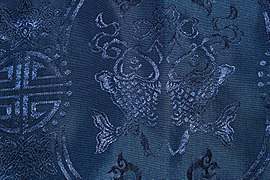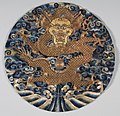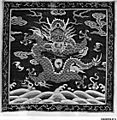
The Chinese Dragon, also known as the loong, long or lung, is a legendary creature in Chinese mythology, Chinese folklore, and Chinese culture at large. Chinese dragons have many animal-like forms such as turtles and fish, but are most commonly depicted as snake-like with four legs. Academicians have identified four reliable theories on the origin of the Chinese dragon: snakes, Chinese alligators, thunder worship and nature worship. They traditionally symbolize potent and auspicious powers, particularly control over water.

A mandarin square, also known as a rank badge, was a large embroidered badge sewn onto the surcoat of officials in Imperial China, Korea, in Vietnam, and the Ryukyu Kingdom. It was embroidered with detailed, colourful animal or bird insignia indicating the rank of the official wearing it. Despite its name, the mandarin square falls into two categories: round buzi and square buzi. Clothing decorated with buzi is known as bufu in China. In the 21st century, the use of buzi on hanfu was revived following the Hanfu movement.

Chinese clothing includes the traditional hanfu and garments of ethnic minorities, as well as modern variations of indigenous Chinese dresses. Chinese clothing has been shaped through its dynastic traditions, as well as through foreign influences. Chinese clothing showcases the traditional fashion sensibilities of Chinese culture traditions and forms one of the major cultural facets of Chinese civilization.
Dragon robes, also known as gunlongpao or longpao for short, is a form of everyday clothing which had a Chinese dragon, called long (龍), as the main decoration; it was worn by the emperors of China. Dragon robes were also adopted by the rulers of neighbouring countries, such as Korea, Vietnam, and the Ryukyu Kingdom.

Much traditional Chinese art was made for the imperial court, often to be then redistributed as gifts. As well as Chinese painting, sculpture and Chinese calligraphy, there are a great range of what may be called decorative or applied arts. Chinese fine art is distinguished from Chinese folk art, which differs in its style and purpose. This article gives an overview of the many different applied arts of China.

The Twelve Ornaments are a group of ancient Chinese symbols and designs that are considered highly auspicious. They were employed in the decoration of textile fabrics in ancient China, which signified authority and power, and were embroidered on vestments of state.

The Twelve Symbols national emblem was the state emblem of the Empire of China and the Republic of China from 1913 to 1928. It was based on the ancient Chinese symbols of the Twelve Ornaments.

Mianfu is a kind of Chinese clothing in hanfu; it was worn by emperors, kings, and princes, and in some instances by the nobles in historical China from the Shang to the Ming dynasty. The mianfu is the highest level of formal dress worn by Chinese monarchs and the ruling families in special ceremonial events such as coronation, morning audience, ancestral rites, worship, new year's audience and other ceremonial activities. There were various forms of mianfu, and the mianfu also had its own system of attire called the mianfu system which was developed back in the Western Zhou dynasty. The mianfu was used by every dynasty from Zhou dynasty onward until the collapse of the Ming dynasty. The Twelve Ornaments were used on the traditional imperial robes in China, including on the mianfu. These Twelve Ornaments were later adopted in clothing of other ethnic groups; for examples, the Khitan and the Jurchen rulers adopted the Twelve ornaments in 946 AD and in 1140 AD respectively. The Korean kings have also adopted clothing embellished with nine out of the Twelve ornaments since 1065 AD after the Liao emperor had bestowed a nine-symbol robe to the Korean king, King Munjong, in 1043 AD where it became known as gujangbok.
Traditional Korean patterns are often featured throughout Korea on architecture, clothes, porcelain, necessities, and more. These patterns can be recognized either by one of the four time periods they originated from, or by their shape.

Suzhou embroidery, Su embroidery or Su xiu is the embroidery created around the city of Suzhou, Jiangsu, China. It is one of the oldest embroidery techniques in the world and is the most representative type of art in Chinese embroidery. One of the well-known "four great embroideries of China" along with Cantonese embroidery, Sichuan embroidery and Xiang embroidery, Suzhou embroidery already has a history more than 2,000 years and is an important form of handicraft in the history of Chinese art and folk custom, representative of Chinese traditional folk arts. It is famous for its variety of stitches, beautiful patterns, elegant colors, and consummate craftsmanship.

Yunjian, also known as Cloud collar in English and sometimes referred as châr-qâb, is a Chinese term which can either to a four-lobed motif, or to a traditional Chinese garment accessory item in Hanfu, the Traditional clothing of the Han Chinese, which is typically found in the form of a detachable collar with cloud patterns and is worn over the shoulders area, similar to a shawl. As an garment accessory, the yunjian is also typically found in four-lobed design although multi-lobed design also existed throughout history. The yunjian could also be applied directly on garments, where it would fall around the collar of robes onto the chest and shoulder region,or as a clothing appliqué. In China, the yunjian has both ceremonial and practical uses when used in clothing. As a garment item, the yunjian was an important clothing element for Chinese women, especially in the Ming and Qing dynasties; its usage was spread across China where it became associated with the Han Chinese's wedding clothing. In Henan, brides would wear yunjian decorated with hanging ribbons and bells. It also had the practical use of preventing clothing from being dirty and oily by covering up the clothes and by covering up the stains. The yunjian is used in Peranakan wedding; the multi-layered yunjian worn by Chinese brides on the day of their wedding is sometimes known as "phoenix collar". The yunjian also started to be worn by the Non-Chinese, the Tartars of northern China and Manchuria in the later medieval period.

Qungua, also known as longfenggua, or longfeng qungua, or guaqun, is one type of two-piece ceremonial traditional Chinese wedding set of attire, which is composed of a jacket called gua (褂) and of a long Chinese skirt called qun (裙). The qungua is a type of Hanfu worn by Han Chinese brides and originated in the 18th century during the Qing dynasty. It eventually became the traditional wedding attire of Cantonese brides in the Guangdong regions. It is traditionally handmade and is decorated with dragons and phoenixes embroideries. Nowadays, the qungua is still popular as a wedding dress in China, including in Hong kong and Macau.
Mangfu, also known as mangpao, huayi, and python robe, sometimes referred as dragon robe although they are different garments, in English, is a type of paofu, a robe, in hanfu. The mangfu falls under the broad category of mangyi, where the mangfu is considered as being the classic form of mangyi. The mangfu was characterized by the use of a python embroidery called mang although the python embroidery is not a python snake as defined in the English dictionary but a four-clawed Chinese dragon-like creature. The mangfu was derived from the longpao in order to differentiate monarchs and subjects; i.e. only the Emperor is allowed to wear the long, five-clawed dragon, while his subjects wears mang. The mangfu was worn in the Ming and Qing dynasties. They had special status among the Chinese court clothing as they were only second to the longpao. Moreover, their use were restricted, and they were part of a special category of clothing known as cifu, which could only be awarded by the Chinese Emperor in the Ming and Qing dynasties, becoming "a sign of imperial favour". People who were bestowed with mangfu could not exchange it with or gifted it to other people. They were worn by members of the imperial family below of crown prince, by military and civil officials, and by Official wives. As an official clothing, the mangfu were worn by officials during celebration occasions and ceremonial events. They could also be bestowed by the Emperor to people who performed extraordinary services to the empire as rewards, to the members of the Grand Secretariat and to prominent Daoist patriarchs, imperial physicians, tributary countries and local chiefs whose loyalty were considered crucial to secure the borders. The mangfu is also used as a form of xifu, theatrical costume, in Chinese opera, where it is typically found in the form of a round-necked robe, known as yuanlingpao. In Beijing opera, the mangfu used as xifu is known as Mang.
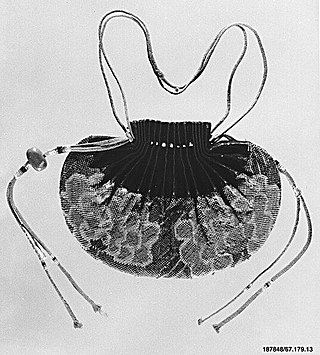
Hebao, sometimes referred as Propitious pouch in English, is generic term used to refer to Chinese embroidery pouches, purses, or small bag. When they are used as Chinese perfume pouch, they are referred as xiangnang, xiangbao, or xiangdai. In everyday life, hebao are used to store items. In present-days China, xiangbao are still valued traditional gifts or token of fortune. Xiangbao are also used in Traditional Chinese medicine.

Qizhuang, also known as Manfu and commonly referred as Manchu clothing in English, is the traditional clothing of the Manchu people. Qizhuang in the broad sense refers to the clothing system of the Manchu people, which includes their whole system of attire used for different occasions with varying degrees of formality. The term qizhuang can also be used to refer to a type of informal dress worn by Manchu women known as chenyi, which is a one-piece long robe with no slits on either sides. In the Manchu tradition, the outerwear of both men and women includes a full-length robe with a jacket or a vest while short coats and trousers are worn as inner garments.

Lishui or shuijiao is a set of parallel diagonal, multicoloured sea-waves/line patterns. It originated in China where it was used by the Qing dynasty court prior to the mid-18th century. Lishui represents the deep sea under which the ocean surges and waves; it is therefore typically topped with "still water", which is represented by concentric semicircle patterns which runs horizontally. Lishui was used to decorate garments, including the bottom hem and cuffs of some of the court clothing of the Qing dynasty. It could be used to decorate as wedding dress items. It is also used to decorate Chinese opera costumes, typically on the bottom hem of the costumes. It was also adopted in some court clothing of the Nguyen dynasty in Vietnam under the influence of the Qing dynasty.

Xiangyun, are traditional Chinese stylized clouds decorative patterns. They are also known as yunwen, auspicious clouds, lucky clouds, and sometimes abbreviated as clouds in English. A type of xiangyun which was perceived as being especially auspicious is the five-coloured clouds, called qingyun, which is more commonly known as wuse yun or wucai xiangyun, which was perceived as an indicator of a kingdom at peace.

Baijiayi, also known as baijiapao and sometimes referred as One hundred families robe, Hundred-Families robe, or One hundred families clothing in English, is a form of Chinese patchwork jacket, particular for male children. The baijiayi is used as a protective talisman for children. It is a traditional Han Chinese custom garment, which has been passed down for centuries.
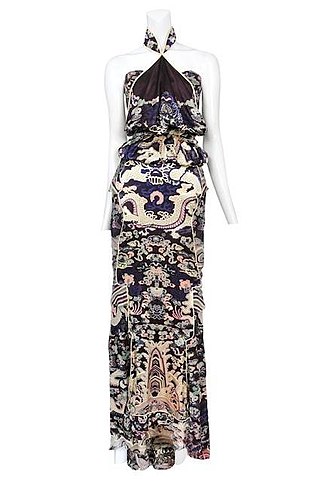
Chinoiserie in fashion refers to the any use of chinoiserie elements in fashion, especially in American and European fashion. Since the 17th century, Chinese arts and aesthetic were sources of inspiration to European artists, creators, and fashion designers when goods from oriental countries were widely seen for the first time in Western Europe. Western chinoiserie was also often mixed with other exotic elements which were not all indigenous to China.













































